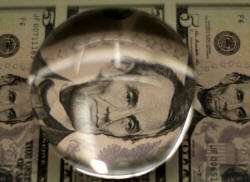Dollar nurses losses but set for big monthly drop; franc
slips
 Send a link to a friend
Send a link to a friend
 [January 29, 2018]
By Saikat Chatterjee [January 29, 2018]
By Saikat Chatterjee
LONDON (Reuters) - The dollar consolidated
losses against a basket of currencies on Monday as U.S. bond yields rose
but traders were cautious on the broader outlook as recent strong data
has not changed expectations about the path of U.S. interest rates.
Data on Friday showed U.S economic growth accelerated to 2.3 percent in
2017, faster than the 1.5 percent logged in 2016, although growth in the
December quarter slowed on a sequential basis and was below market
expectations.
Lee Hardman, a currency strategist at MUFG, said the strong data should
encourage the Fed to adopt a more confident tone in this week's policy
meeting and will only cement expectations of another rate hike in March.
But "the updated signal is unlikely to prove sufficient to prompt the
market to price in more rapid tightening beyond the Fed's current plans
for three hikes this year, thereby dampening support for the U.S.
dollar", he added.

Treasury Secretary Steven Mnuchin gave U.S. currency bears a major boost
last week with a tacit endorsement of a weak dollar. While U.S.
President Donald Trump, who has advocated a strong dollar, tried to row
back from those comments, the damage had already been done and the
greenback's downturn since November showed little sign of abating.
Against a basket of currencies <.DXY>, the dollar bounced a quarter of a
percent higher to 89.30 after scoring six consecutive weeks of losses.
On a monthly basis it is set to fall 3 percent.
Over the last decade, including the global financial crisis in 2008, it
has fallen by that extent only 10 times, according to Thomson Reuters
data.
Reuters data points to market expectations of about three more Federal
Reserve rate hikes this year, starting in March, although some analysts,
including at Goldman Sachs and JP Morgan Asset Management expect the Fed
to raise four times.
U.S. Treasury yields climbed to fresh multi-year highs in European trade
on Monday, extending rises seen last week as investors braced for major
central banks to step back from ultra-easy monetary policies. The
10-year yield rose to 2.71 percent, its highest since early 2014.

FRANC WEAKNESS
The Swiss franc was the day's underperformer, declining more than a
quarter of a percent against the dollar and weaker against the crosses
after weekly deposits data showed a pick up in capital outflows.
[to top of second column] |

Sheets of former U.S. President Abraham Lincoln on the five-dollar
bill currency are inspected through a magnifying glass at the Bureau
of Engraving and Printing in Washington March 26, 2015. REUTERS/Gary
Cameron/File Photo

The franc has traditionally been a countercyclical currency for global
funds as it tends to gain when risk aversion is on the rise and vice
versa, although that correlation has weakened thanks to central banks'
unconventional monetary policies.
But as the European Central Bank starts to unwind its multi-year policy
stimulus starting this month, market watchers expect the Swiss currency
to weaken substantially as domestic investors look to international
markets for better returns.
"We expect the SNB (Swiss National Bank) to lag the other European
central banks in normalizing monetary policy as the exchange rate
remains highly overvalued and as outflows from the Swiss market have
picked up pace. That should be a relief for the SNB," said Kamal Sharma,
a director of G10 FX strategy at Bank of America Merrill Lynch.
While the franc <CHF=> edged 0.3 percent weaker against a broadly
struggling dollar, it was also on the back foot against the euro, with
the currency stabilizing above the 1.16 line.
UBS Wealth Management expects the franc to weaken to 1.19 against the euro <EURCHF=>
as the gap between ECB policy withdrawal and SNB's precautionary stance is
likely to widen.
Chairman Thomas Jordan reaffirmed the SNB's view on the currency earlier this
month, saying the Swiss franc remained "highly valued" and negative interest
rates were still needed.
The euro <EUR=EBS> traded at $1.2400, down 0.2 percent and off a three-year peak
of $1.2538 touched on Thursday.

The single currency's failure over the past couple of days to stay above $1.25
is seen by some traders as a sign of fatigue in its six-week old rally.
Data from U.S. financial watchdog the Commodity Futures Trading Commission
showed speculators' net long position in the euro/dollar futures traded in
Chicago rose to a record high, suggesting that profit-taking could be on the
cards. <1099741NNET>
(Reporting by Saikat Chatterjee; Editing by Catherine Evans)
[© 2018 Thomson Reuters. All rights
reserved.] Copyright 2018 Reuters. All rights reserved. This material may not be published,
broadcast, rewritten or redistributed.
Thompson Reuters is solely responsible for this content. |